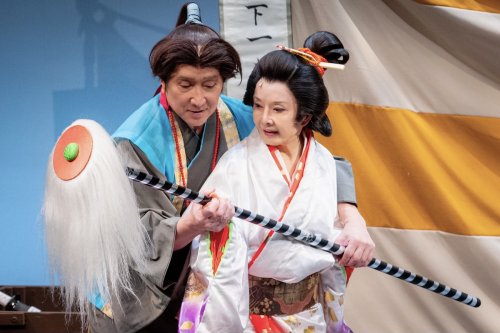Okuni: The Woman Who Created Kabuki
A limited, fictionalized account of the woman who is thought to have created Kabuki in the late 17th century.

Yashushi Kimura and Ako in a scene from Dachs’ “Okuni: The Woman Who Created Kabuki” at Theatre Row (Photo credit: Russ Rowland)
Okuni: The Woman Who Created Kabuki by Ako Dachs is a limited, fictionalized account of the woman who is thought to have created Kabuki. It is generally accepted that the dance and theater form called Kabuki developed in late 17th century Japan, but its exact details lack solid evidence.
This production is mostly based on the few records still existing from that period. The performance is highly stylized, a mixture of Japanese noh and Kabuki theatrical forms. The play is presented in Japanese, with English supertitles projected on a screen at the back of the stage.
Izumo no Okuni is believed to have been a temple dancer from the Izumo Taisha Shrine in Izumo in Western Japan. She is believed to have traveled to Kyoto, some 400 miles away, to dance the temple dances for alms to support the shrine. All of the stories about her indicate that during her time in Kyoto, she began to change the temple dances into a new form of dance that borrowed elements from Noh theater and developed her style. Her dance form was less formal than the other dance and theater forms of the time and was geared to appeal to a broader segment of the Japanese population. The older dance traditions were only available to the rich and nobility.

Ako in a scene from Dachs’ “Okuni: The Woman Who Created Kabuki” at Theatre Row (Photo credit: Russ Rowland)
She formed an all-female dance troupe to perform what at first were unstructured sensual and sexualized performances that later began to be shaped by stories of folklore and history as the popularity of her troupe increased. The name Kabuki is believed to be based on a term used to describe oddly dressed and swaggering men who were called kabukimono. Ako uses this form to introduce a samurai character, Nagoya Sansaburo, who is considered to have influenced some of the stories told by Okuni’s troupe. The colorful, unstructured form of Okuni’s performances led people to refer to her dances as Kabuki.
Ako’s portrayal of Izumo no Okuni combines traditional Japanese dance movements with Western-style acting. The nature of the script limits the impact of her performance. The dialogue is simplistic, verging on a museum presentation. The story being told is too small for someone who is such a large character in the folklore of Japan. It is a story that calls for a larger cast to show the impact her dance and performance style could have on audiences. Okuni certainly did not dance alone, so what needs to be added is the pageantry and bravado of a fully engaged dance ensemble. Dachs also portrays Lady Yodo, the mistress of the late Toyotomi Hideyoshi, credited with the unification of Japan that led to the establishment of the Tokugawa shogunate.
Yasushi Kimura plays Nagoya Sansburo, a real figure in Japanese history, as well as two other characters: the fictional characters of Kosuke, a Dengaku dancer who also performs Kagura using masks, and Kanbei, the head swordsmith in the area of Izumo. Kosuke is a central character in Ako’s staging, adding necessary dramatic notes to fill out the story. Kimura, a Japanese stage, film, and TV actor, is also an accomplished performer of traditional Japanese theater forms, including Kabuki. His characterizations are solid but limited by the nature of the script.

Musicians Fumi Tanakadate and Yasushi Kamura with Ako in a scene from Dachs’ “Okuni: The Woman Who Created Kabuki” at Theater Row (Photo credit: Russ Rowland)
Fumi Tanakadate and Ako Dachs created the original compositions. Tanakadate, a young musician, expertly performs them on flute and a variety of Japanese drums. According to my colleague Sam Leiter, a scholar of Japanese theater, “Her musical accompaniment allows for a number of charming Japanese song and dance sequences by both actors.”
The set design by Josh Dachs comprises a simple peddler’s cart filled with props, some platforms at different levels, and a striped curtain arranged between two posts at the center of the performance area. Cinthia Chen’s projection design on the screen at the back of the stage enhances the settings by showing images of traditional Japanese prints, some with simple animation, and images of Ako in various dance positions as she performs the moves on the stage. The lighting design by Aaron Bowersox works well in shifting the focus of the action and giving an emotional touch to the setting. Ako Dachs designed the costumes with the multiple wigs designed by Mitsuteru Okuyama.
Okuni: The Woman Who Created Kabuki (through November 23, 2024)
Amaterasu Za
Theatre Row, 410 West 42nd Street, in Manhattan.
For tickets, visit https://bfany.org/theatre-row/shows/okuni/
Running time: 90 minutes without an intermission






Leave a comment